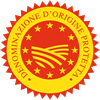Description
The Reblochon PDO is a soft-paste cheese produced with raw and whole milk of cows from Abondance, Tarine and Montbéliarde breeds.
Production Area
The production area of Reblochon PDO is located in Haute-Savoie, in the eastern part of Annecy and in Val d'Arly in Savoie. It includes 176 municipal areas in Haute-Savoie and nine in Savoie, in the region of Rhone-Alps.
Production Method
The milk is coagulated within 24 hours from the first milking at a temperature between 30°C and 35°C with the addition of rennet, without any heat treatments. Later, the curd is cut to obtain grains the size of corn, which are put into the cheese moulds. The paste is pressed for some hours and this enables the dripping of the cheese and to eliminate the excessive whey. After dripping, the cheese moulds are immersed into the salt brine for one or two hours before being put in cellars and start ripening. The cheese remains for about a week in a drier and are turned every day, plus their rind is washed more times.
Appearance and Flavour
Reblochon PDO has a flat cylindrical shape with a diameter of 13-14 cm and a thickness of 3.5 cm, whilst the weight is between 450 gr and 550 gr. There is also a small cheese version, whose diameter measures about 9 cm and the weight is between 230 gr and 280 gr. The rind has an orange-yellow colour covered with a thin layer of white mousse. The paste is creamy with a buttery and bodied flavour and a slight aftertaste of hazelnut.
History
The history of Reblochon PDO goes back to the 13th century. In that period, the farm holders, generally monks or nobles, enjoyed of the right d'ociège, in other words they could be paid by farmers, who were the occupants of their lands, depending on the amount of milk produced in a day. Usually, the farmers, when the holders wanted to collect the rent, made an incomplete milking to obtain a lower amount of milk and continued it when the holder was already went away. The name of this cheese has originated from this practise: indeed, in Franco-Provencal language, blecher means to milk and reblecher, to re-milk. The milk obtained by the second milking was only a low amount, but it was suitable to produce cheese, as it was rich of cream.
Gastronomy
Reblochon PDO must be conserved in the least cold compartment of the refrigerator, wrapped in its original package or in a sealed box. Before tasting it, it is suggested to leave it at room temperature for about two hours. Reblochon PDO can be eaten all year and is traditionally a cheese to be eaten at the end of a meal, but it can be also tasted with salad dishes or fine cut as aperitif. It is perfect with dry fruits like walnuts, hazelnuts, figs and apricots. Savoie wines like Apremont, Roussette de Savoie and Chignin-Bergeron are perfect with its strong flavour.
Marketing
The product is sold as Reblochon PDO. It is sold whole or in portions and must show a casein plate with the identification number of the production farm.
Distinctive Features
Reblochon PDO's taste is due to the unchanged methods of preparation and to the ability and skills of producers.






